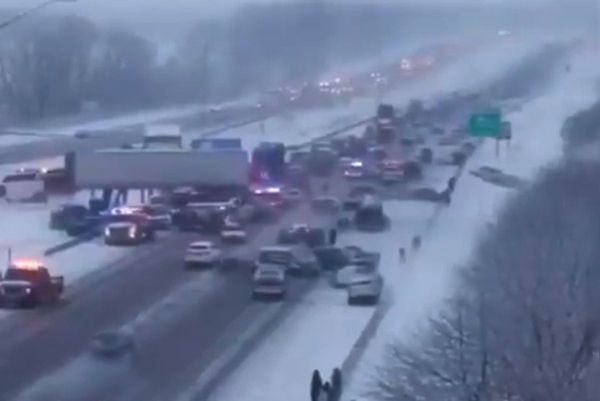
On a late summer day in September, the sound of cicadas pierced the profound silence in the sprawling grasslands and gently rolling hills of the San Rafael Valley in southern Arizona. But before long, the shrill buzzing gave way to the rumble of heavy machinery sculpting an unpaved road leading to the US-Mexico border.
In the distance, a deer darted across the road and disappeared into a thicket of oak trees. A few miles later, a fenced-in worker camp came into view, next to a construction site full of trucks, bulldozers and cranes.
The San Rafael Valley, south-east of Tucson, is considered one of the most biodiverse regions in North America. But in recent days, a towering black steel wall has begun to rise on the landscape.
The Trump administration is forging ahead with plans to erect a 27-mile section of the border wall here, despite a legal challenge still playing out in the courts. When completed, the 30ft-high barrier will tear through one of the last pristine, unbroken grasslands in the west.
Trump’s pledge to “build the wall” between the US and Mexico was a top priority during his first term, but the 1,954-mile border is still full of gaps. Construction in this remote valley is among efforts in several states to fast-track new sections along the southern border.
The new wall is intended replace low barriers that stop vehicles but still allow wildlife to get across. Even before construction began, many Arizonans worried about the plan’s impact on the numerous wildlife species that regularly move between the two countries – including jaguars, ocelots, bears and mountain lions.
“The wildlife there have existed for and evolved over thousands of years in a connected ecosystem and this wall will sever populations in half,” says Russ McSpadden, south-west conservation advocate at the Center for Biological Diversity. The barrier, he says, can prevent animals – including the endangered jaguar – from migrating to find food and mates, which could mean their eventual extinction.
The possibility of water depletion has also concerned residents in an arid landscape that’s already grappling with drought. New wells are being drilled for drawing up groundwater to mix with concrete for the wall foundation. Previous border wall projects have required vast quantities of water, running into the hundreds of thousands of gallons per day.
“It’s disheartening to see some wall panels already up,” said Erick Meza, the borderlands coordinator for the Sierra Club. “This whole place looks like an industrial area now. And we know it’s just the beginning.”
The wall is taking shape even as a legal challenge proceeds in federal court over the Trump administration’s issuing of waivers that nullify more than 30 environmental and public health laws to accelerate construction. Kristi Noem, the director of the Department of Homeland Security, has characterized the wall project as necessary to prevent people from entering the country unlawfully.
John Mennell, a spokesperson for Customs and Border Protection (CBP), which oversees wall construction, declined to comment on the lawsuit or any of the concerns raised.
But local residents such as Linda Shore, director of the Red Rock Acres Homeowners Association in the former mining outpost of Patagonia near the border, aren’t convinced.
Shore isn’t thrilled about the wall, or the construction traffic that could lead to accidents at what she says is a hazardous intersection near her home.
But for her, the bigger issue has to do with how the wall could hurt wildlife and drain water resources at a time when unlawful border crossings are at all-time lows.
Data from Customs and Border Protection show that, in Arizona, such crossings in August were down more than 90% over August 2024 along the Tucson sector that covers 262 miles of border. And this part of the San Rafael Valley has not traditionally been a frequent crossing site, according to some area residents and conservation groups that monitor animal movement along the border with cameras.
“In my mind, it’s a big show of force for nothing,” says Shore.
The San Rafael Valley spreads out between the Madrean Sky Islands that span both sides of the border. The biomes of the isolated mountain ranges change with elevation from desert to forest, creating a unique ecosystem where thousands of animals thrive.
Human history also has left its mark on the remote valley over the span of centuries. By the late 1800s, the vast expanse had beckoned cattle ranching operations that became a significant economic driver in the area. Some cattle ranches remain in what is a mix of federal, state and private land that – thanks to conservation efforts – is largely undisturbed. Over time, small rural communities like Patagonia were built around it.
Those and other communities in Arizona and Sonora, Mexico, will inevitably feel the effect of a wall that is likely to alter the ecosystem balance and overall health of the land, says Zach Palma, the Mexico projects manager for the Sky Island Alliance, a Tucson conservation non-profit. “That type of degradation, in the long run, does indirectly affect everyone, especially these rural communities whose livelihood is dependent on the land, whether it’s ranching or farming.”
The non-profit works with ranchers and small-scale farmers in Santa Cruz, Sonora, a small community within the broader Sky Island region that already struggles with shallow groundwater. “With the drought, they’ve been experiencing their wells going deeper and deeper,” Palma says.
John Fanning, a member of the Santa Cruz county board of supervisors, says some of his constituents live in the far eastern reaches of the county, which includes San Rafael. Some of those rural residents favor a wall near their communities because of previous encounters with border crossers “showing up on their properties and giving them a scare”.
But others are wary that the wall could cause water scarcity.
“We don’t know what’s going to happen to the wells of some of the folks that live out there,” says Fanning. “But in my opinion, I don’t think it is going to have a positive effect. If anything, it’s going to perhaps deplete the water out there that these folks rely on.”
There has been little transparency about the wall construction since it was announced, says Fanning. But representatives from the federal agency and Fisher Sand & Gravel, the North Dakota-based contractor working on the more than $300m project, recently informed a local committee of government officials and residents that about 150 workers will build the steel bollard wall over the next 30 months. The company did not respond to the Guardian’s request by phone for further details about the project.
“I feel that the federal government, if that’s what they want to have happen, it’s going to happen,” he says. “But it’s great to know what’s going to happen so that I can then let the constituents of our county, especially in that area, have an idea of the progress that’s being made.”
The tractor-trailers carrying construction equipment and frequently driving past rural communities toward the border is becoming a familiar sight for residents. They bypass the town center of Patagonia, but travel on a road that’s in front of Shore’s subdivision.
Carol Bonchalk-Hilton, who lives on the edge of the valley in the former mining boomtown of Washington Camp, says that at night she can see the dark skies light up from the worker camp. Her home is in the sparsely populated community 16 miles away.
The retiree doesn’t mind border walls built in places where it might be needed, but says she thinks surveillance technology would have been a better alternative for San Rafael.
Instead, says Bonchalk-Hilton, the wide-open views of the valley are “now going to be blackened by a massive wall going through it. You’ve got the wildlife going back and forth. That’s the problem.”







